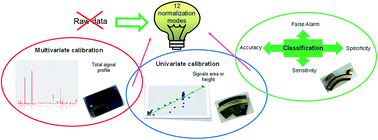Twelve different types of data normalization for the proposition of classification, univariate and multivariate regression models for the direct analyses of alloys by laser-induced breakdown spectroscopy (LIBS)†
Abstract
This study applies laser-induced breakdown spectroscopy (LIBS) for the direct analysis of 80 metal samples (alloys and steel) for multivariate and univariate regression models, aiming at the determination of 10 analytes (Al, Cr, Cu, Fe, Mn, Mo, Ni, Ti, V and Zn). To optimize the LIBS system, the Doehlert design was used for energy, delay time and spot size adjustment for all samples and analytes. Twelve normalization modes were used to reduce the interference matrix and to improve the calibration models, with error values ranging from 0.27% (Mn) to 14% (Cu and Ni). Models without normalization presented two- to five-fold higher errors. In addition to quantification, classification models (KNN, SIMCA and PLS-DA) were also proposed for sample differentiation. Multivariate and univariate models presented similar performance, and among the classification models, KNN presented the best results, with an accuracy of 100%.

- This article is part of the themed collection: Analytical Atomic Spectrometry in South America


 Please wait while we load your content...
Please wait while we load your content...